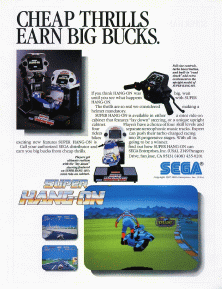
Atari Games Corporation was an American producer of arcade video games, active from 1985 to 1999, then as Midway Games West Inc. until 2003. It was formed when the coin-operated video game division of Atari, Inc. was transferred by its owner Warner Communications to a joint venture with Namco, being one of several successor companies to use the name Atari.
Racing games are a video game genre in which the player participates in a racing competition. They may be based on anything from real-world racing leagues to fantastical settings. They are distributed along a spectrum between more realistic racing simulations and more fantastical arcade-style racing games. Kart racing games emerged in the 1990s as a popular sub-genre of the latter. Racing games may also fall under the category of sports video games.

Sega Rally Championship is a 1995 racing game developed and published by Sega. Originally released for arcades using the Sega Model 2 board, ports were published for the Sega Saturn in 1995 and Microsoft Windows in 1997. The Sega Rally Championship simulates driving on different surfaces, with different friction properties, with the car's handling changing accordingly. As the first racing game to incorporate this feature, Sega Rally Championship is considered to be one of the milestones in the evolution of the racing game genre. It was also an early rally racing game and featured cooperative gameplay alongside the usual competitive multiplayer.

Daytona USA is a 1994 arcade racing game developed by Japanese studio Sega AM2. Inspired by the popularity of the NASCAR motor racing series in the US, the game has players race stock cars on one of three courses. It was the first game to be released on the Sega Model 2 arcade system board. Released by Sega in March of 1994, Daytona USA is one of the highest-grossing arcade games of all time.

Virtua Racing or V.R. for short, is a Formula One racing video game developed by Sega AM2 and released for arcades in 1992. Virtua Racing was initially a proof-of-concept application for exercising a new 3D graphics platform under development, the "Model 1". The results were so encouraging that Virtua Racing was fully developed into a standalone arcade title.
Ocean Software Ltd was a British software development company that became one of the biggest European video game developers and publishers of the 1980s and 1990s.
1992 saw many sequels and prequels in video games, such as Dragon Quest V, Final Fantasy V, Sonic the Hedgehog 2, Street Fighter II: Champion Edition, Super Mario Land 2: 6 Golden Coins, and Super Mario Kart, along with new titles such as Art of Fighting, Lethal Enforcers, Mortal Kombat and Virtua Racing.

Super Hang-On is a motorcycle racing arcade video game released by Sega as the sequel to Hang-On. It uses a simulated motorcycle arcade cabinet, like the original game. An updated version was released in arcades 1991 as Limited Edition Hang-On.

Radikal Bikers is a racing arcade game developed by the Spanish company Gaelco in 1998, with also a conversion for PlayStation developed instead by Bit Managers, it was only released in Europe. The spiritual successor to this game was Smashing Drive.

Alligator Hunt is a shoot 'em up arcade game released by Spanish company Gaelco in 1994.

Super Monaco GP is a Formula One racing simulation video game released by Sega, originally as a Sega X Board arcade game in 1989, followed by ports for multiple video game consoles and home computers in the early 1990s. It is the sequel to the 1979 arcade game Monaco GP. The arcade game consists of one race, the Monaco Grand Prix, but later ports added more courses and game modes based on the 1989 Formula One World Championship.

Gabinete Electrónico Consultivo, S.A., but is trademarked and better known as Gaelco, S.A., is a Spanish company that develops and publishes arcade games and video games. As of 2007, Gaelco develops electronic dart machines under the name of "Gaelco Darts".
Zigurat was a Spanish software house for 8-bit home computers very popular in the eighties. Its origin is in the company Made in Spain, founded in 1983, which would know massive success in Spain with Fred, commercialized in the United Kingdom as Roland on the Ropes. When the programmers and owners of Made in Spain could not go on alone on the task of distribution, they decided to create in 1986 another company, Zigurat, which would be entirely dedicated to distribution, and would distribute all the titles by Made in Spain, which became an internal producer seal under Zigurat. They would also distribute games by independent programmers or companies and would allow Made in Spain to concretate solely on programming. Later on, Made in Spain would completely merge into Zigurat, creating a single producer and distributor company. When the 8-bit market disappeared, the company turned to develop games for arcade machines.

Knuckle Bash is a 1993 side-scrolling beat 'em up arcade video game developed and published by Toaplan in Japan, as well as North America and Europe by Atari Games. It is notable for being one of the few titles by Toaplan that has not received any official port to home consoles as of date.
The golden age of Spanish software was a time, between 1983 and 1992, when Spain became the second largest 8 bit computer entertainment software producer in Europe, only behind the United Kingdom. The disappearance of the 8 bit technology and its replacement by the 16 bit machines marked the end of this era, during which many software companies based in Spain launched their career: Dinamic Software, Topo Soft, Opera Soft, Made in Spain and Zigurat among others. The name Edad de oro del soft español was coined by specialized magazines of the time and has been used to refer to these years until nowadays.

Casual Arts, formerly known as Flair Software, is a British video game developer and publisher of the 1990s that developed and published games for the Amiga, Amiga CD32, Atari ST, Commodore 64, DOS, PlayStation, Sega Saturn and SNES. It was set up by Colin Courtney in 1990 after his previous company, Tynesoft, went bankrupt. It retained Tynesoft's MicroValue brand and published Elvira: The Arcade Game which had originally been scheduled for publication by Tynesoft.
The history of video gaming in Spain dates back to the 1970s, and by 2014 the country was the 10th-highest-grossing market for video games worldwide. In 2018, the Spanish video game market posted a revenue of €1.53 billion, up from €1.35 billion in 2017. The country's audience of game players was 16.8 million that year; demographically, it was 59% male and 41% female. Reportedly 80% of people aged 6-to-10 played video games, while 24% of those in the 45–64 age range did so.

Carlos Sainz: World Rally Championship is a 1990 racing video game co-developed by the Spanish companies Zigurat Software and Arcadia Software, and published by Zigurat for Amstrad CPC, MS-DOS, MSX and ZX Spectrum. Featuring Spanish rally driver Carlos Sainz and themed around rallying, the game pit players with races across various locations to qualify for the next course in the World Rally Championship and modify characteristics of the Toyota Celica to accommodate each courses.

Sito Pons 500cc Grand Prix is a 1990 racing video game developed and published by the Spanish company Zigurat Software for Amstrad CPC, MS-DOS, MSX and ZX Spectrum. Featuring former Spanish racer Sito Pons and themed around motorcycle racing, the game pit players driving the Honda NSR500 with races against AI-controlled opponents across various countries to qualify in the 500cc class of the Grand Prix motorcycle racing.















